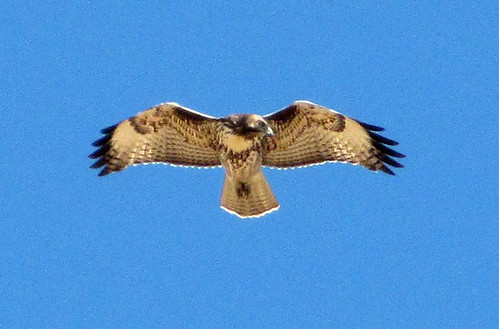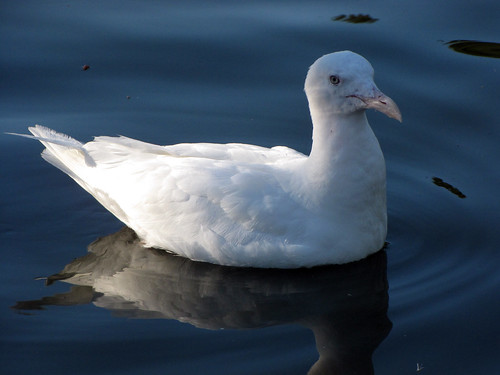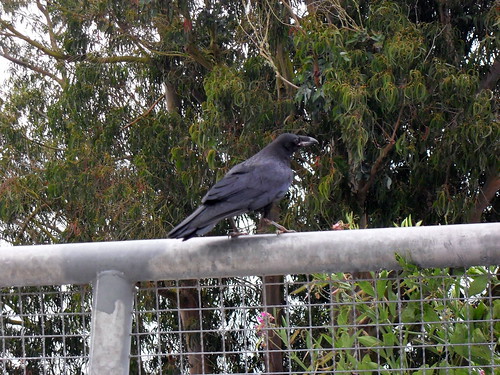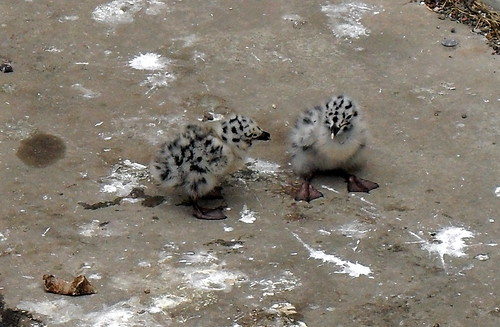Sunday, January 31, 2010
 The gulls return
The gulls return
6:16 PM | Posted by
Sweep Commander |
Edit Post

click on the image to view it in a larger size
We'll see if they brought their dancing shoes. The gull population is swelling rapidly with courtship and territorial marking behavior now common among them.
Odds, ends
- There are several hundred cormorants in the waters to the west and north-west. Some of them were clearly of the double-crested variety. We saw western grebes and western gulls in their midst, and we're very interested in identifying members of other cormorant species in the mob.
- Several porpoises were seen surfacing east of the island today.
- Last week, a heermann's gull was spotted on the dock. Though I missed it, I was able to positively identify it because one conservancy employee, thinking the gull was "funny looking", took a cellphone photo.
- For only the second time in two years, I observed a black oystercatcher on Alcatraz. Early last year, I spotted one near the dock. This time, I saw one flying over the bay near the island's east side.
Friday, January 29, 2010
 Island's western gull males remind desirious females that Valentine's Day is a ways off
Island's western gull males remind desirious females that Valentine's Day is a ways off
8:21 PM | Posted by
Sweep Commander |
Edit Post
Thinking I might have the opportunity to document some early mating, I recorded this female, the smaller gull on the left, trying to entice her male. She positioned herself with her back to her partner and began the upward movement of the head seen in the video, along with the vocalization that accompanies it.This is how one western gull tells another that he or she wants food or sex.
However, just as I hit the record button, the male gull violently denied her, giving her instead a stern bite to the neck. This occurs in the video's opening moment.
We observed similar interactions among other western gull pairs, albeit without the violence.
Odds and ends
- Canada geese have arrived on Alcatraz. We can't be everywhere on the island at once, but our sense now that we're hosting around eight or so. The canada goose is divided into several subspecies and one of the next items on our amateur bird detective agenda is to find out what subspecies our geese belong to.

- The pigeon guillemots have also returned, seemingly going from invisible and absent to ubiquitous and loud in about a week.

- Brown pelicans now fly over the island with regularity. As recently as a year ago, pelicans not sick or injured avoided Alcatraz as if it were the center of evil and dishonor in the bird universe. While this isn't exactly a sensational observation, it's no less baffling for that. What has changed?
- Numerous brandt's cormorants have been seen on Alcatraz and in the waters around it. We can't wait to see if they return to breed.
- The common raven pair has been far less visible over the last week or two.
- The falcon had a bloody adventure recently. Stay tuned to MAGANRORD for BourbonHawk's upcoming post. Here's a little taste:
I wonder what she has there.
Saturday, January 23, 2010
 Looking toward the months ahead, cont'd
Looking toward the months ahead, cont'd
12:01 PM | Posted by
Sweep Commander |
Edit Post
After reading Bourbonhawk's terrific post in which she used her photographs and remembrances of nesting seasons past to look forward to 2010, I had to contribute one of my own.
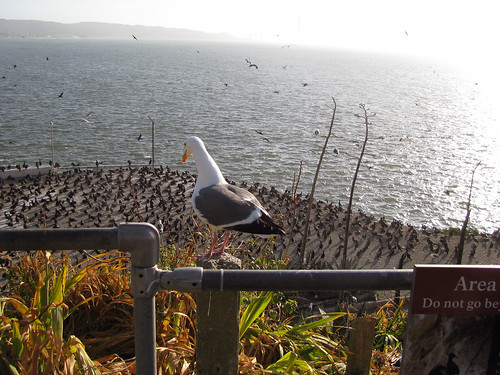
Will these beleaguered cormorants return?
Or will we be again faced with a full summer of this:
If they come back, will their numbers be anywhere close to where they were two years ago, when they were the most numerous bird on the island? Or will the recovery of the Alcatraz cormorant colony be slow and difficult?
Will any smiley mallard couples be joining us?
It can get pretty metal out there. Between our warlike western gulls, our massive and cunning ravens and marauding birds of prey, what carnage will be wrought in 2010?
Is that an untended seagull fledgeling I spy down there?
And... well hello there. Who are you? And just what do you have to do with Alcatraz?
Stay tuned to MAGANRORD to find out, and for soul shattering coverage of Alcatraz Nesting Season 2010!
Friday, January 22, 2010
 Looking toward the months ahead
Looking toward the months ahead
4:53 PM | Posted by
BourbonHawk |
Edit Post
This past week has been rainy and miserable out on the island and nearly entirely lacking in good bird activity. The weather is supposed to be like this for several days to come so in lieu of anything current, I thought I'd post a few pictures from last summer. After all, it's almost nesting season, and there will be nearly an entirely different host of players for the spring and summer.
These can serve to whet your appetites a bit for what we've got coming in just a couple of months.
Piegeon Guillemot
Fledgling Raven
Snowy Egret
Western Gull with Chicks
Two-Day Old Western Gull Chicks
Monday, January 18, 2010
 Big Bad Ravens
Big Bad Ravens
11:39 PM | Posted by
BourbonHawk |
Edit Post
In the ancient mythologies of the American Pacific-Northwest, Ravens were often trickster deities.
Well I'm here to tell you that it's not a myth. AT ALL.
We have a breeding pair of ravens on the island (who you will be introduced to in a future post). Today I came upon them hanging out in our historic Victorian gardens. Our gardeners work extremely hard to maintain both the beauty and historical accuracy of these gardens. Being the tricksters they are, the ravens obviously find this HILARIOUS.
Upon landing in the garden, the first thing the male raven did was investigate some bamboo edging that had been painstakingly placed there. And he deemed it stupid so he pulled it up. The female stood by, amused I'm sure at the thought of the gardeners showing up in the morning and exclaiming "What kind of jerk would come down here and pull up our bamboo edging for NO REASON?"
Seeing how much his random vandalism amused his lady, the male raven then decided he was going to pretend he was a classy Victorian gentleman and proceeded to walk around the garden paths, strutting like he owned the place. The female cawed in appreciation at his antics.
Can you believe the nerve of these guys?
Sunday, January 17, 2010
 PEREGRINE FALCON GALLERY
PEREGRINE FALCON GALLERY
10:57 PM | Posted by
LadyBird |
Edit Post

FALCON: hey bro, I'mma get you back for that whole pesticide falcon genocide thing... but for now I want to show you my pictures from one of the greatest winter vacations of all time!
behold the falcon's aforementioned raditude...
 DEATH FROM ABOVE
DEATH FROM ABOVE
10:10 PM | Posted by
Sweep Commander |
Edit Post
While summer nesting season on Alcatraz is a bonanza for bird nerds, here is one reason why winter season can be just as rewarding for those tickled by bird life and behavior.
On November 22, 2009, fellow Maganrord blogger BourbonHawk, National Park Service Ranger John Cantwell and I got our first glimpse of the peregrine falcon now making itself at home in the tops of the island's cypress and eucalyptus trees, the water tower, the top of the power plant's smoke stack, and the shoots of agave adjacent to the west road and parade ground. A careful survey of these areas will give you a better than even chance of spotting it.
This peregrine is about the size of a seagull or a raven and is thus a probable female, though this is a difficult determination to make. Male and female falcons display what wildlife biologists like to call "reverse sexual dimorphism" – a term that is so ill conceived I'm embarrassed to even use it. In the zoology biz it means that males of the species are generally smaller than females. Regular old "sexual dimorphism" is present in species where males are larger. (C'mon, wildlife biologists. This is silly. Having smaller males than females is just the other kind of sexual dimorphism. Don't make me tell you your business!)
She is a formidable and sharply observant hunter. When a peckish peregrine notices a small or medium sized bird flying below, her wings fold in and the barrel of her body tips down towards the earth as she begins to dive. A peregrine dive was once clocked at 242 miles per hour, the fastest known speed to be reached by any animal under its own power. For the falcon, a successful dive yields an instantaneous kill.
It's a good bet that she's taken a few pigeons and starlings off our hands.
Worldwide, the peregrine lives and breeds on six continents and has around 20 recognized subspecies. Our falcon is a probably a member of the North American variety, Falco peregrinus anatum. 'Anatum', being latin for "duck eater", references the the bird's love of duck meat. For the same reason, the North American peregrine was once also known as the duck hawk.
Even given its record setting aeronautical feats, what's remarkable about this falcon is its survival story. The first half of the 20th century was as gloomy for the peregine as it was on Alcatraz. Though a fearsome bird, anatum proved defenseless against the scourge of the pesticide DDT. Widely used in American agriculture from the 1940s through its eventual ban in 1972, DDT's effects upon birds were as brOOtal as any metal front man's growl. The pesticide thinned anatum's eggshells and the embryos enclosed in these defective confines failed in catastrophic numbers. The peregrine falcon almost disappeared from the North American continent, and the anatum subspecies nearly disappeared from the planet.
We owe the pleasure of our falcon's visit, at least in part, to a popular movement that raised awareness of the public health and environmental dangers of DDT and eventually secured a ban on the agricultural use of the toxin. A captive breeding program for peregrine falcons was then instrumental in resuscitating the North American population. The species has even been successful in adapting to city life, very much enjoying the taste of our urban pigeon populations.
We here at Maganrord HQ would argue that not only is our visiting peregrine undeniably rad, but that whenever a member of a recovering bird population – poisoned by human activity to the threshold of extinction – can find a winter home in a fortress prison turned National Park site and bird sanctuary, she is a living reminder of the powerful impact made by our popular conservation movements.
Sadly, it's not all unicorns and rainbows for the brave heroine. Her stay with us is likely to be relatively brief given her uneasy rapport with the island's year-round inhabitants. We've seen her struggle violently in mid-air with the island's raven pair. She's also made aggressive gestures towards our seagulls who've retaliated by collectively chasing her into the bay, though so far, she has always returned. With breeding season and fledgeling chicks to protect on the horizon, we amateurs at Maganrord expect the island's gull population to turn up the heat on the wintering falcon if she doesn't decide to leave on her own terms.
Still, it's pretty good while it lasts.

Subscribe to:
Posts (Atom)





